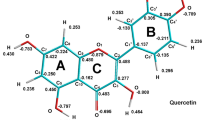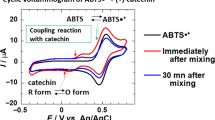Abstract
The condensation of taxifolin with glyoxylic acid was examined, and the properties of the resulting product were compared with those of taxifolin. The structure of the product was determined by NMR spectroscopy. The ability of the polyphenols to scavenge reactive oxygen species (ROS) was estimated by luminol-dependent chemiluminescence. The iron-chelating and iron-reducing activities were studied using absorption spectrophotometry. It was shown that the condensation leads to the formation of a dimer consisting of two taxifolin units linked through a carboxymethine bridge at the C-6 and C-8 positions of the A ring. The dimer exhibited a somewhat higher ROS scavenging activity than taxifolin. The iron-binding capacity of the compounds was proportional to the number of polyphenol units. The iron-reducing ability of the dimer was lower than that of taxifolin. Thus, the dimer possessed a higher antioxidant activity than the parent flavonoid. The data obtained may be useful for a better understanding of processes occurring in foods and beverages and in a search for new active compounds.





Similar content being viewed by others
References
Baderschneider B, Winterhalter P (2001) Isolation and characterization of novel benzoates, cinnamates, flavonoids, and lignans from Riesling wine and screening for antioxidant activity. J Agric Food Chem 49:2788–2798. doi:10.1021/jf010396d
Cerezo AB, Tesfaye W, Soria-Díaz ME et al (2010) Effect of wood on the phenolic profile and sensory properties of wine vinegars during ageing. J Food Compos Anal 23:175–184. doi:10.1016/j.jfca.2009.08.008
Chen ZY, Chan PT, Ho KY et al (1996) Antioxidant activity of natural flavonoids is governed by number and location of their aromatic hydroxyl groups. Chem Phys Lipids 79:157–163. doi:10.1016/0009-3084(96)02523-6
De Simón BF, Sanz M, Cadahía E et al (2014) Polyphenolic compounds as chemical markers of wine ageing in contact with cherry, chestnut, false acacia, ash and oak wood. Food Chem 143:66–76. doi:10.1016/j.foodchem.2013.07.096
Drinkine J, Lopes P, Kennedy JA et al (2007) Ethylidene-bridged flavan-3-ols in red wine and correlation with wine age. J Agric Food Chem 55:6292–6299. doi:10.1021/jf070038w
Es-Safi NE, Cheynier V, Moutounet M (2000) Study of the reactions between (+)-catechin and furfural derivatives in the presence or absence of anthocyanins and their implication in food color change. J Agric Food Chem 48:5946–5954. doi:10.1021/jf000394d
Es-Safi N-E, Cheynier V, Moutounet M (2002) Role of aldehydic derivatives in the condensation of phenolic compounds with emphasis on the sensorial properties of fruit-derived foods. J Agric Food Chem 50:5571–5585. doi:10.1021/jf025503y
Foti M, Piattelli M, Baratta MT, Ruberto G (1996) Flavonoids, coumarins, and cinnamic acids as antioxidants in a micellar system. Structure–activity relationship. J Agric Food Chem 44:497–501. doi:10.1021/jf950378u
Gunda SK, Narasimha SKM, Shaik M (2014) P56lck kinase inhibitor studies: a 3D QSAR approach towards designing new drugs from flavonoid derivatives. Int J Comput Biol Drug Des 7:278–294. doi:10.1504/IJCBDD.2014.061648
Hoefnagel AJ (1993) Glyoxylic acid: a key chemical. TU Delft, Delft University of Technology, Delft
Ivanova SZ, Gorshkov AG, Kuzmin AV et al (2012) Phenolic compounds of Siberian and Dahurian larch phloem. Russ J Bioorganic Chem 38:769–774. doi:10.1134/S1068162012070096
Jerez M, Touriño S, Sineiro J et al (2007) Procyanidins from pine bark: relationships between structure, composition and antiradical activity. Food Chem 104:518–527. doi:10.1016/j.foodchem.2006.11.071
Jomova K, Valko M (2011) Advances in metal-induced oxidative stress and human disease. Toxicology 283:65–87
Jung H, Shin SY, Jung Y et al (2015) Quantitative relationships between the cytotoxicity of flavonoids on the human breast cancer stem-like cells MCF7-SC and their structural properties. Chem Biol Drug Des. doi:10.1111/cbdd.12512
Kiehlmann E, Li EPM (1995) Isomerization of dihydroquercetin. J Nat Prod 58:450–455. doi:10.1021/np50117a018
Li A-N, Li S, Zhang Y-J et al (2014) Resources and biological activities of natural polyphenols. Nutrients 6:6020–6047. doi:10.3390/nu6126020
Mira L, Fernandez MT, Santos M et al (2002) Interactions of flavonoids with iron and copper ions: a mechanism for their antioxidant activity. Free Radic Res 36:1199–1208. doi:10.1080/1071576021000016463
Mladěnka P, Macáková K, Filipský T et al (2011) In vitro analysis of iron chelating activity of flavonoids. J Inorg Biochem 105:693–701. doi:10.1016/j.jinorgbio.2011.02.003
Navas Díaz A, García Sánchez F, González Garcia JA (1998) Phenol derivatives as enhancers and inhibitors of luminol-H2O2-horseradish peroxidase chemiluminescence. J Biolumin Chemilumin 13:75–84. doi:10.1002/(SICI)1099-1271(199803/04)13:2%3C75::AID-BIO469%3E3.0.CO;2-7
Ostronkov V, Lashin S (2012) Method for producing dihydroquercetin. Patent WO 2012064229.
Pazos M, Gallardo JM, Torres JL, Medina I (2005) Activity of grape polyphenols as inhibitors of the oxidation of fish lipids and frozen fish muscle. Food Chem 92:547–557. doi:10.1016/j.foodchem.2004.07.036
Rice-Evans CA, Miller NJ, Paganga G (1996) Structure-antioxidant activity relationships of flavonoids and phenolic acids. Free Radic Biol Med 20:933–956
Říha M, Karlíčková J, Filipský T et al (2014) In vitro evaluation of copper-chelating properties of flavonoids. RSC Adv 4:32628. doi:10.1039/C4RA04575K
Rødtjer A, Skibsted LH, Andersen ML (2006) Identification and quantification of phenolics in aromatic bitter and cherry liqueur by HPLC with electrochemical detection. Eur Food Res Technol 223:663–668. doi:10.1007/s00217-005-0250-4
Rohdewald P (2002) A review of the French maritime pine bark extract (Pycnogenol), a herbal medication with a diverse clinical pharmacology. Int J Clin Pharmacol Ther 40:158–168. doi:10.5414/CPP40158
Roy K, Mitra I (2009) Advances in quantitative structure–activity relationship models of antioxidants. Expert Opin Drug Discov 4:1157–1175
Saucier C, Guerra C, Pianet I et al (1997) (+)-Catechin—acetaldehyde condensation products in relation to wine-ageing. Phytochemistry 46:229–234. doi:10.1016/S0031-9422(97)00268-9
Shatalin IV, Shmarev AN (2010) Peroxidation of lecithin in the presence of dihydroquercetin and its complex with ferrous iron ions. Biofizika 55:75–82. doi:10.1134/S0006350910010112
Shatalin YV, Shubina VS (2014) Partitioning of taxifolin-iron ions complexes in octanol-water system. Biophysics (Oxf) 59:351–356. doi:10.1134/S000635091403021X
Shubina VS, Shatalin YV (2013) Absorption spectroscopy study of acid-base and metal-binding properties of flavanones. J Appl Spectrosc 80:761–766. doi:10.1007/s10812-013-9838-9
Teixeira S, Siquet C, Alves C et al (2005) Structure-property studies on the antioxidant activity of flavonoids present in diet. Free Radic Biol Med 39:1099–1108. doi:10.1016/j.freeradbiomed.2005.05.028
Vauzour D, Rodriguez-Mateos A, Corona G et al (2010) Polyphenols and human health: prevention of disease and mechanisms of action. Nutrients 2:1106–1131
Wang HX, Ng TB (1999) Natural products with hypoglycemic, hypotensive, hypocholesterolemic, antiatherosclerotic and antithrombotic activities. Life Sci 65:2663–2677. doi:10.1016/S0024-3205(99)00253-2
Weidmann AE (2012) Dihydroquercetin: more than just an impurity? Eur J Pharmacol 684:19–26
Wollmann N, Hofmann T (2013) Compositional and sensory characterization of red wine polymers. J Agric Food Chem 61:2045–2061. doi:10.1021/jf3052576
Zhou H-C, Tam NF, Lin Y-M et al (2014) Relationships between degree of polymerization and antioxidant activities: a study on proanthocyanidins from the leaves of a medicinal mangrove plant Ceriops tagal. PLoS ONE 9:e107606. doi:10.1371/journal.pone.0107606
Acknowledgements
The Authors are thankful to Molchanov M.V. from the Institute of Theoretical and Experimental Biophysics for recording the NMR spectra. The study was carried out using the facilities of the Center of Collective Use of the Institute of Theoretical and Experimental Biophysics of Russian Academy of Sciences. This study was supported by the Russian Foundation for Basic Research [Projects Nos. 15-04-02377 (V.S.S) and 14-44-03622 (Y.V.S)].
Author information
Authors and Affiliations
Corresponding author
Rights and permissions
About this article
Cite this article
Shubina, V.S., Shatalin, Y.V. Antioxidant and iron-chelating properties of taxifolin and its condensation product with glyoxylic acid. J Food Sci Technol 54, 1467–1475 (2017). https://doi.org/10.1007/s13197-017-2573-0
Accepted:
Published:
Issue Date:
DOI: https://doi.org/10.1007/s13197-017-2573-0




